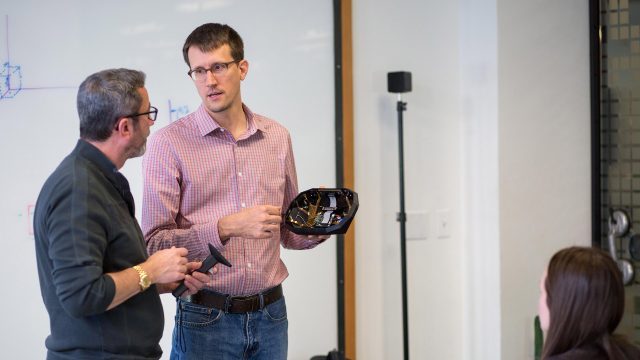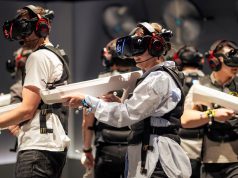In August of last year, Valve created the SteamVR licensing program to allow any developer to create their very own SteamVR tracked object. At that time, Valve partnered with Synapse, a Seattle-area product development firm, to provide a mandatory training program for all SteamVR licensees. Road to VR met with Synapse’s electrical engineering program lead and SteamVR Tracking instructor, Doug Bruey, to talk about the tracking system and how it will be used by companies in the future.
From his experience teaching the SteamVR Tracking course, Bruey has an inside view on what companies are doing with the technology and when we might begin to see the fruits of their labor.
Road to VR:
How many students went through the SteamVR tracking training course?
Doug Bruey:
We had 15 courses with 149 attendees from 113 different companies.
Road to VR:
What was the mix of the students by their respective industries?
Doug Bruey:
It was really varied. I would say it’s 50% from gaming, but from the earliest classes we saw people from a variety of different markets. We’ve seen people from the automotive industry, advertising, athletics, gaming, computers, education, hospitals, industrial training and farming. We’ve had a couple different NASA contractors come through who were working on training simulations and setups for astronauts. There’s usually a pretty big part of the class that will be working on gaming and gaming accessories but the other half will come from other markets that you may not have expected.
Road to VR:
What’s the best guess for when the first product will come out from one of these course graduates?
Doug Bruey:
I would guess that you might expect to see something announced at the end of this year. The typical product cycle being about 18 months. Since people started taking this course in the fall of last year, once they get back and get started, I would expect you might start to see some products being announced and released towards the end of this year and beginning of next.
Road to VR:
Getting to Seattle is a difficulty for some VR startups. Is having a remote course something that you would consider providing in the future?
Doug Bruey:
It’s something that we’d be willing to do if there were people in who are interested in bringing us out. In March, Valve announced that the course is no longer required for licensees because the documentation has been dialed in well enough and the tools have been refined enough that people can pick it up and get the work started up on their own. Since that happened, we’ve seen a drop off in demand for the course because people don’t have to take it. They can go off and do it on their own.
We think the course can really accelerate the development effort and make sure that companies are really on the fast track for things they need to learn up front and to avoid any pitfalls. But we are a product development firm as well as a technical training firm, so if people are able to pick up the documentation and run with it and do the work they want to do, then the more power to them really. This technology will have wider access in the marketplace because there are fewer barriers to getting started.

Road to VR:
You’ve produced some prototype hardware for the course and that seems like something that people would still like to have access to. Is there any way for people to purchase or acquire that from Synapse?
Doug Bruey:
We’ve developed prototype circuit boards and built that into a [tracked] reference object. Licensees get access to all the design files and they get access to everything they need to build it up themselves. If they want to buy hardware off-the-shelf, that reference design has been picked up by Triad Semiconductor. That is the group that developed the ASIC for the photo-sensor and you can buy those and the circuit boards themselves directly from Triad Semiconductor. We’ve developed the designs and Triad is producing them for retail.
Road to VR:
Last year at Steam Dev Days, Valve unveiled the knuckle controllers. Is that something that Synapse had a role in developing?
Doug Bruey:
Insofar as the new controller from Valve is based off of the electrical and firmware architecture that Synapse helped develop: we’ve definitely been involved in that way. But the product development, in terms of its ergonomics and its mechanics and controls and all the things that make that a unique product, that is a Valve effort.
Road to VR:
What are you excited for in the future of virtual and augmented reality?
Doug Bruey:
I’m excited to see how it moves into other markets and what kind of solutions it creates in places that nobody expected. Just like gaming is the tip of the spear in the performance of PCs, people take advantage of that in order to improve completely different computing areas. I see the same thing happening with VR.
On the market side, gaming is going to drive VR forward and once it becomes commercially viable at a consumer price point, then people with fantastic ideas in therapy or medical devices or cinema or any of these other areas, then they are going to get access to that technology because it will be reduced to a price that they can afford to play around with and develop on. At that point, we’ll see whole new solutions pop up in those areas. I’m really interested to see where VR finds its unique place in these other market verticals.
The other part of the other part of it that I’m really interested to see is where it’s going to drive technology, too. We have these ultra-high resolution displays on our laptops and our brain thinks “Wow, I can’t tell the difference between them anymore because my eyes can’t see the pixels.” Where does the display technology go from here? I think it’s interesting how we are going to need something like 16K displays because our eyes are so close to them. In order to get that retina-display resolution in a VR setting, we are going to need even higher resolutions.
The other thing is there are different video compression methods that are needed. Right now, for Netflix and other online video distribution platforms, latency isn’t a problem, so they can use compression methods that work across multiple frames. They get incredibly high compression ratios in order to deliver that content, but with VR the drive is always going to be how do I get that tether off of my system? How do I become as unencumbered as possible with no wire and hopefully no backpack on my back? If you do that and you want to communicate that video wirelessly, especially when you get up to 4K or higher, it’s going to be an incredible amount of data. It also needs to be delivered with incredibly low latency, down below 25 milliseconds or so, and so you can’t afford to wait to offer up multiple frames for your compression algorithm. You need to be able to do your compression in a smarter, lower latency way. I think we’re going to start to see some really interesting development in VR compression and ultimately gaming in general.
VR is going to again be the tip of the spear, it’s going to be driving the lowest latency possible. But then who knows what people are going to find use for that in other applications, from gaming to anything else that is trying to deliver really low latency video.









